Review and photos by Steven Bochenek
Two Testfests (bet you can’t say that three times fast) ago, the 2012 Hyundai Veloster won the Automobile Journalists Association of Canada’s award for Best New Design. A TestFest Best. Over the past week, the 2013 Veloster Turbo, its latest update, has continually proven itself a sporty little number that doesn’t suffer from any sophomore curse or performance anxiety.
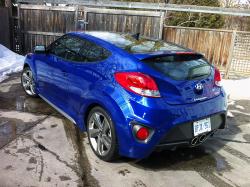 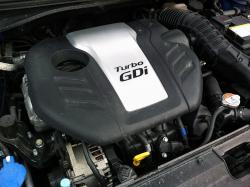 2013 Hyundai Veloster Turbo. Click image to enlarge |
Indeed, it has been a lot of fun and there are many positives to report, the key being overall value. The only ‘upgrades’ on the Veloster Turbo are the automatic transmission and matte paint. But never mind those, at $26,249 base MSRP, it is well equipped enough to embarrass some luxury cars.
But nobody buys a feisty sportster to save money, so let’s begin with a discussion of performance.
As the name suggests, the Hyundai Veloster Turbo boasts an efficient turbocharged 1.6L four-cylinder engine. It’s slightly noisy, but that’s part of the fun. It puts out a respectable 201-hp at 6,000 rpm and 185 lb-ft torque at 1,750. That may not sound like much if you’re piloting a hefty crossover with all-wheel drive and dragging a snowmobile. But the other key ingredient of performance engineering is weight.
At just 1,270 kilos soaking wet, the Veloster Turbo weighs only 35 more than my Mini Clubman. Which makes it like a pinball – or maybe the analogy should be a slingshot, given its rather noticeable turbo lag followed by a thoroughly satisfying liftoff.
The Veloster Turbo isn’t just thrusty though. It likes to bend suddenly in the corners. I was fortunate to have it a couple of extra days and put nearly 1,000 km on the odometer. It’s been fun on nearly every inch. In fact, I took it out of the city twice for overnight stays in the country.
The first time there was ice everywhere and the front-wheel-drive system had no problems launching. Where there are Hankook Kontrol Technology 18-inch winter tires, there’s less need for all-wheel drive. I turned off the traction control and enjoyed the oversteer a couple of times, a thrill so intense in the right conditions, you can expect the government to find a way to tax it soon.
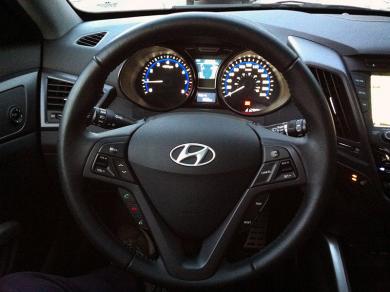 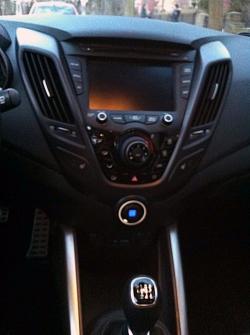 2013 Hyundai Veloster Turbo. Click image to enlarge |
The second trip was just four days later, amid monsoon rains that melted the country snow base by half. The muddy puddles at times lapped the chassis. It was filthy good fun, although off-roading and mudslinging aren’t quite what the Veloster was designed for.
The braking system, complete with electronic brakeforce distribution, is especially alert and contributed significantly to the whole drive. Catapulting so readily out of sharp corners had as much to with the precise braking as the thrust.
The sport-tuned steering performs best in the highest gears. Slipping into spaces in traffic was always easy. In first and reverse, it’s a bit of a workout but the leather-bound steering wheel feels satisfying.
The publicized fuel consumption stats for this tester (manual transmission) are 7.5 L/100 km in the city and 5.3 on the highway. I never came close to either of those, even milking the cruise control. You can blame part of that on the excess of weather we’ve been experiencing this winter. Heating, winter tires and ugly traffic all do their part to downgrade optimistic mileage figures.
Did someone just mention optimistic fuel economy?
   2013 Hyundai Veloster Turbo. Click image to enlarge |
Alas, like Kia, Hyundai has programmed the My First Stick Shift™ instructions into the computer. The warnings begin finger wagging at you to upshift the millisecond you hit 2,000 rpm. Considering the Veloster Turbo’s gutsy looks and Hyundai’s performance aspirations, this ‘feature’ is sending a mixed message. Meaning? If you expect drivers to take this to a track day or autocross event, that suggestion to upshift should come just before the needle hits the red zone.
It likely exists for those frugal few who purchase a standard transmission because, driven right, it can be much more fuel efficient than an automatic. Of course that begs the question: don’t most people who want to be told when to shift gears buy an automatic?
You can’t switch off or de-program My First Stick Shift™, but you can ignore it during those times you genuinely want to rev higher. (Hello, barreling eighteen-wheeler rapidly cancelling the merging lane!) Besides, like most annoying little things, from banner ads to requests for money from family, you stop noticing it after a while.
Anyway the gears slide comfortably and the ratios are sensibly spaced to allow the driver some movement before having to upshift.
But first let’s talk a bit more about what the Veloster Turbo was not designed for. At 4,250 mm long, it’s not supposed accommodate cross-country skis, a snowboard, groceries, two suitcases, two satchels, a passenger and still have leftover room. There are only 440 L of cargo space in the trunk but flatten the back seats and that increases plenty – enough for a fun weekend in the country anyway.
    2013 Hyundai Veloster Turbo. Click image to enlarge |
Speaking of design, it has some very interesting features. Be sure to review the photo section. The chrome handles inside the front doors are solid though barely attached, standing apart from the door. On the driver’s side there are only three window buttons to command. That’s because there are only three doors, not including the hatch. It’s another quirk of Hyundai’s engineers, who clearly inhaled in college. The passenger side has the only door to the rear seat. Its outer handle is cached up in the top corner above the window.
Now that we’re outside: the Veloster has an uncompromising look that inspired either envy or contempt in observers. (I think it looks cool; I’m not alone in that opinion, nor am I legion.) It’s meant to look like a helmet. Maybe, kind of – the thought just makes me imagine a huge scary head.
Now let’s see what jewelry comes with that price tag. Heated leather seats, leather-wrapped steering wheel and push-button start are all features you expect in a more expensive car. The alloy pedals have a pleasant shine and auxiliary jacks for the infotainment system are plain civilized. The seven-inch touchscreen was insensitive to my bony fingers’ caress and usually I had to jam the full pad of my thumb hard just to agree that I wouldn’t look at the screen while I was trying to operate it.
It’s seems we’ve inadvertently arrived at the discussion of value. Good. Components of the warranty program are fairly rich (not being all that sexy, warranty talk rarely makes it into review copy, so if it bores you, please skip to the next paragraph): five years or 100,000 km bumper-to-bumper with a few specific exceptions; same time and distance for powertrain, basic emissions and anti-perforation, which means no corroding of the body. But wait, there’s more! Eight-year ‘major’ emissions coverage protects the catalytic converter, engine control module and onboard emissions diagnostic device; three years of unlimited km 24/7 roadside assistance; three years or 60,000 km replacement of dealer-installed accessories; finally, a year or 20,000 km of replacement parts. Whew, see what I mean? Let’s all take a breath and make those impatient readers who skipped ahead wait up for us.
 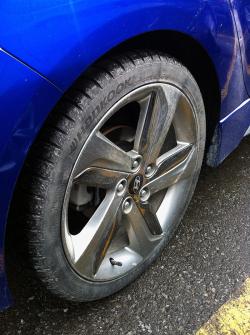 2013 Hyundai Veloster Turbo. Click image to enlarge |
At just 4,250 mm long, 1,805 mm wide and 1,399 mm tall, this car is great for zipping about the city, but despite the aforementioned 440L of trunk space, no one’s accusing it of being roomy. Fortunately, this model includes a panoramic sunroof. It’s not actually ‘panoramic’ because it’s only overhead, but it is really big, taking up most of the roof. On a sunny day it’s a treat. But don’t worry, that doesn’t supplant the air conditioning, which is also baked, or cooled, into the one price.
With that hatchback you don’t have much need for a camera when reversing, but you get one anyway and I got quite used to it fast. Then it got clogged with snow after three days and conditions were too miserable to leave the car and wipe it off with my tie or bare hand. Fortunately the beeping sonar co-alerted me to the solids I was backing towards as indicated by the mirrors.
It’s great to be slung so low – its ground clearance is a charming 143 mm – because you genuinely appreciate speed when your perspective is akin to a turtle’s. However you do want to be visible. The side mirrors have turn signal indicators built in. These don’t just look cool; they attract the attention of those idiots who love your blind spot. Furthermore, the ‘marathon blue’ of the tester is a great name for its impossible-to-ignore hue. It’s not far from the bright purple a marathoner suffering a massive coronary exudes.
Overall, it’s a purchase worth considering if you’re not packing a lot of passengers or freight and enjoy a throaty fun ride. Two last words about all the simplicity of Hyundai pricing and accessories. For $135.45 you can purchase a rubber cargo tray for the floor of your trunk. Get it.
|
Related Articles: Manufacturer’s Website: Photo Gallery: |
Pricing: 2013 Hyundai Veloster Turbo
Base price: $26,249
Accessories: Cargo tray – $135.45
Freight: $1,495
A/C Tax: $100
Price as tested: $27,979.35
Competitors:
Fiat Abarth
Honda Accord Coupe
Scion FR-S
Subaru BRZ
Volkswagen Golf R
Crash Test Results:
National Highway Traffic Safety Administration (NHTSA)
Insurance Institute for Highway Safety (IIHS)










